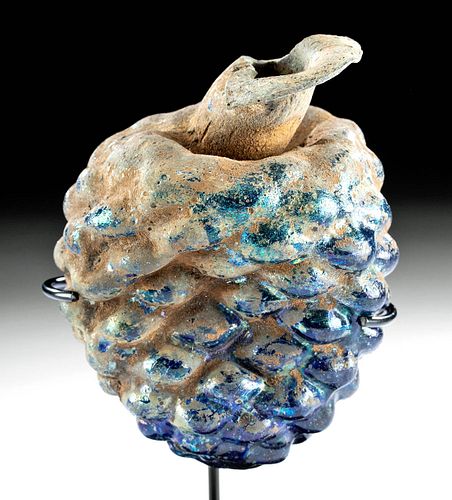Roman Glass Grape Flask w/ Fine Iridescence
Lot 61d
About Seller
Artemis Fine Arts
686 S Taylor Ave, Ste 106
Louisville, CO 80027
United States
Selling antiquities, ancient and ethnographic art online since 1993, Artemis Gallery specializes in Classical Antiquities (Egyptian, Greek, Roman, Near Eastern), Asian, Pre-Columbian, African / Tribal / Oceanographic art. Our extensive inventory includes pottery, stone, metal, wood, glass and textil...Read more
Categories
Estimate:
$5,500 - $8,000
Absentee vs Live bid
Two ways to bid:
- Leave a max absentee bid and the platform will bid on your behalf up to your maximum bid during the live auction.
- Bid live during the auction and your bids will be submitted real-time to the auctioneer.
Bid Increments
| Price | Bid Increment |
|---|---|
| $0 | $25 |
| $300 | $50 |
| $1,000 | $100 |
| $2,000 | $250 |
| $5,000 | $500 |
| $10,000 | $1,000 |
| $20,000 | $2,500 |
| $50,000 | $5,000 |
| $100,000 | $10,000 |
| $200,000 | $20,000 |
About Auction
By Artemis Fine Arts
Feb 13, 2020
Set Reminder
2020-02-13 10:00:00
2020-02-13 10:00:00
America/New_York
Bidsquare
Bidsquare : Exceptional Antiquities, Asian, Ethnographic
https://www.bidsquare.com/auctions/artemis-gallery/exceptional-antiquities-asian-ethnographic-4848
An important one-day auction featuring museum-worthy examples of Egyptian, Greek, Roman, Etruscan, Near Eastern, Far East / Asian, Pre-Columbian, African / Tribal, Oceanic, Native American, Spanish Colonial, Russian, Fossils, Ancient Jewelry, Fine Art, so much more! Artemis Fine Arts info@artemisfinearts.com
An important one-day auction featuring museum-worthy examples of Egyptian, Greek, Roman, Etruscan, Near Eastern, Far East / Asian, Pre-Columbian, African / Tribal, Oceanic, Native American, Spanish Colonial, Russian, Fossils, Ancient Jewelry, Fine Art, so much more! Artemis Fine Arts info@artemisfinearts.com
- Lot Description
Roman, early Imperial Period, ca. 1st to early 2nd century CE. A stunning example of a bulbous flask in the shape of a bunch of grapes, mold-blown from translucent glass of a cobalt-blue hue. The vessel is defined by a generally conical body with a shallow indentation on one side, a rounded shoulder that is compressed on top, a cylindrical neck, and a flared rim. The body is pattern-molded with dozens of petite nodules that represent grapes, and the neck is representative of the stem from which the grapes grow. The entire vessel is enveloped in brilliant layers of rainbow-hued iridescence that gracefully complement the sapphire-blue color of the glass. Size: 3.125" W x 4" H (7.9 cm x 10.2 cm); 4.7" H (11.9 cm) on included custom stand.
Most scholars agree, Roman glass was of the highest quality - both aesthetically and technically - among the ancients. While glass making had been practiced for centuries, glass blowing was invented in the Roman-controlled Holy Land in the 1st century BCE. This innovative technology revolutionized the artform. We can appreciate such a wide variety of forms and shapes, because the medium of glass has unique physical properties that make for so many more possibilities which would eventually replace a wide variety of pottery and metal wares in the ancient world. Roman glassmakers reached incredible artistic heights with both free-blown vessels and mold blown forms and decorations and were traded far beyond the Roman Empire. Roman glass vessels have been found in Scandinavia, India, and in Han Dynasty tombs in China.
For a stylistically similar example made from glass of a nearly identical hue and with a longer neck, please see The Corning Museum of Glass, accession number 64.1.8.
For another stylistically similar example made from translucent purple glass, please see The Metropolitan Museum of Art, accession number 81.10.236.
Provenance: ex-private prominent D.K. collection, New York, USA, acquired in the 2000s
All items legal to buy/sell under U.S. Statute covering cultural patrimony Code 2600, CHAPTER 14, and are guaranteed to be as described or your money back.
A Certificate of Authenticity will accompany all winning bids.
We ship worldwide and handle all shipping in-house for your convenience.
#153101Losses to areas of spout rim, with one stable fissure to indented area of shoulder as shown. Minor nicks and abrasions to rim and body, light weathering, extensive encrustations, and indentations to body and shoulder commensurate with forming process. Nice earthen deposits and fantastic rainbow iridescence throughout.Condition
- Shipping Info
-
All shipping is handled in-house for your convenience. Your invoice from Artemis Gallery will include shipping calculation instructions. If in doubt, please inquire BEFORE bidding for estimated shipping costs for individual items.
-
- Buyer's Premium



 EUR
EUR CAD
CAD AUD
AUD GBP
GBP MXN
MXN HKD
HKD CNY
CNY MYR
MYR SEK
SEK SGD
SGD CHF
CHF THB
THB
















